无钥匙进入系统的架构建模
此示例展示了如何在 System Composer™ 中设置车辆无钥匙进入系统的架构。您还将学习如何为不同的利益相关者创建不同的架构视图。此示例遵循基于模型的系统工程 (MBSE) 工作流:
定义利益相关者需求
定义架构模型
定义构造型以对组件进行分类
定义端口接口以描述数据流
创建供利益相关者查看的视图
openProject("scKeylessEntrySystem");
有关组件上的封装图标的更多信息,请参阅可视化构建架构。
定义利益相关者需求
在 MBSE 设计中,功能需求代表基于设计需要满足的需求和关注点的高级利益相关者需求。运行此命令以打开包含功能需求的 需求编辑器 (Requirements Toolbox)。需要 Requirements Toolbox™ 许可证来检查 System Composer 架构模型中的需求。
slreq.load('FunctionalRequirements');slreq.editor
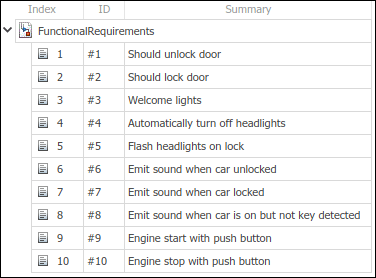
这些利益相关者的需求明确指出,架构模型必须包括门锁和解锁系统、照明控制系统、音响系统和发动机控制系统。这些组件应在通过质量检查后满足需求。有关详细信息,请参阅管理需求。
定义架构模型
无钥匙进入系统的架构包括传感器、机械门锁系统、照明系统、音响系统和发动机控制系统。这些组件根据连接通过端口传递的信息进行交互。每个顶级组件都可以分解为其子组件,以表示架构层次结构。
分解 FOB 定位系统
FOB Locator System 组件包括车辆用于接收无线信号并隔离钥匙位置以锁定或解锁车门的系统。此操作是实现无钥匙进入系统的第一步。
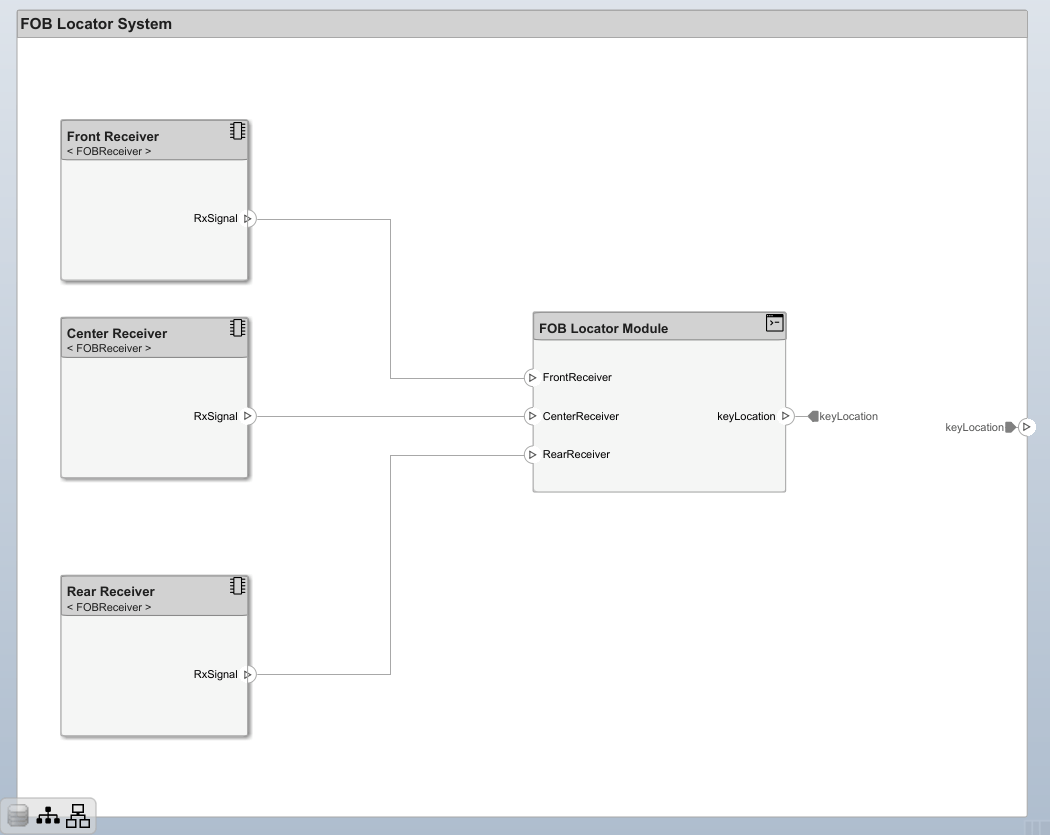
引用架构 FOB Receiver 被重用于对车辆前部、中部和后部的三个接收器进行类型化。每个接收器向确定密钥位置的 RxSignal 组件发送信号 FOB Locator Module,该组件确定密钥位置 keyLocation,并将密钥位置传输给由组件代表的所有其他系统。
分解门锁及解锁系统
关键位置确定后,自动门锁及解锁系统将自动启动。门锁和解锁系统同时具备硬件和软件组件。

该车辆的四扇车门均配备有传感器,用于检测车门是否处于锁定状态。DoorLockSensor 引用架构对这些组件进行分类。根据通过 FOB 传递的信息,Door Lock Controller 组件激活四扇门的作动器,以可选方式实现门锁。DoorLockActuator 引用的架构类型为作动器。门锁状态 doorStatus 从组件 Door Lock Controller 通过边界传输。
分解音响系统
Sound System 组件控制发出声音以指示键的位置、门状态和发动机状态。
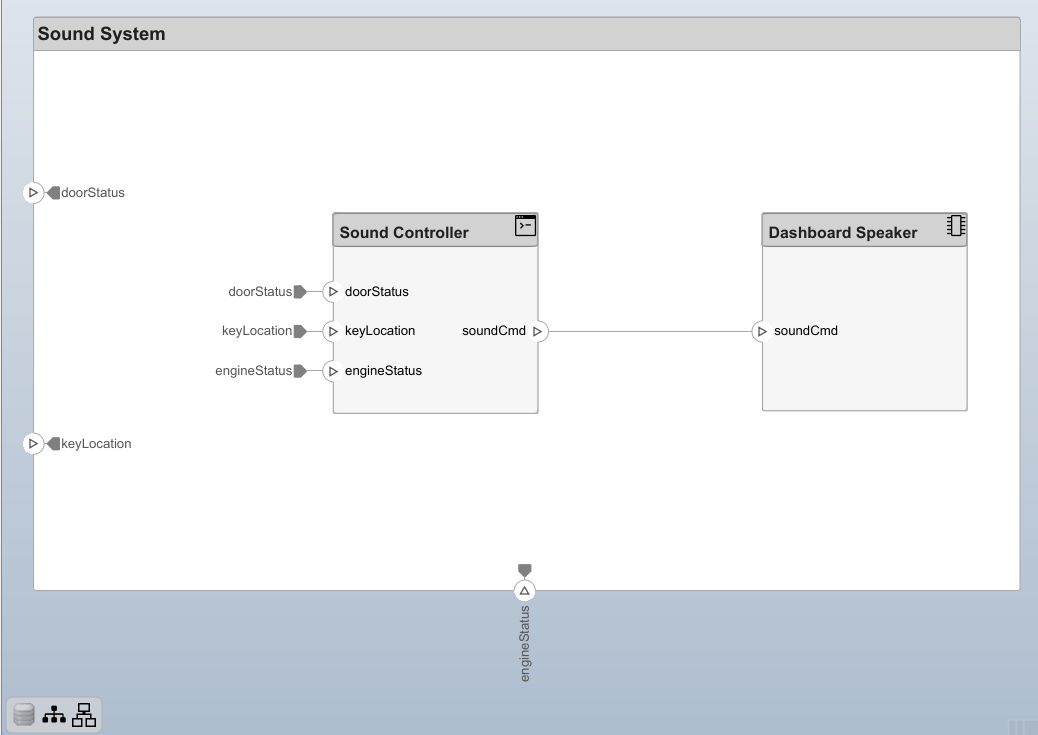
Sound ControlleR 组件的软件向 Dashboard Speaker 组件发送命令,以处理和发出声音。
分解发动机控制系统
发动机控制系统包含一个用于控制制动系统、变速器和发动机的控制系统。无钥匙进入系统会激活一个无钥匙启动控制器,用于启动或停止车辆。
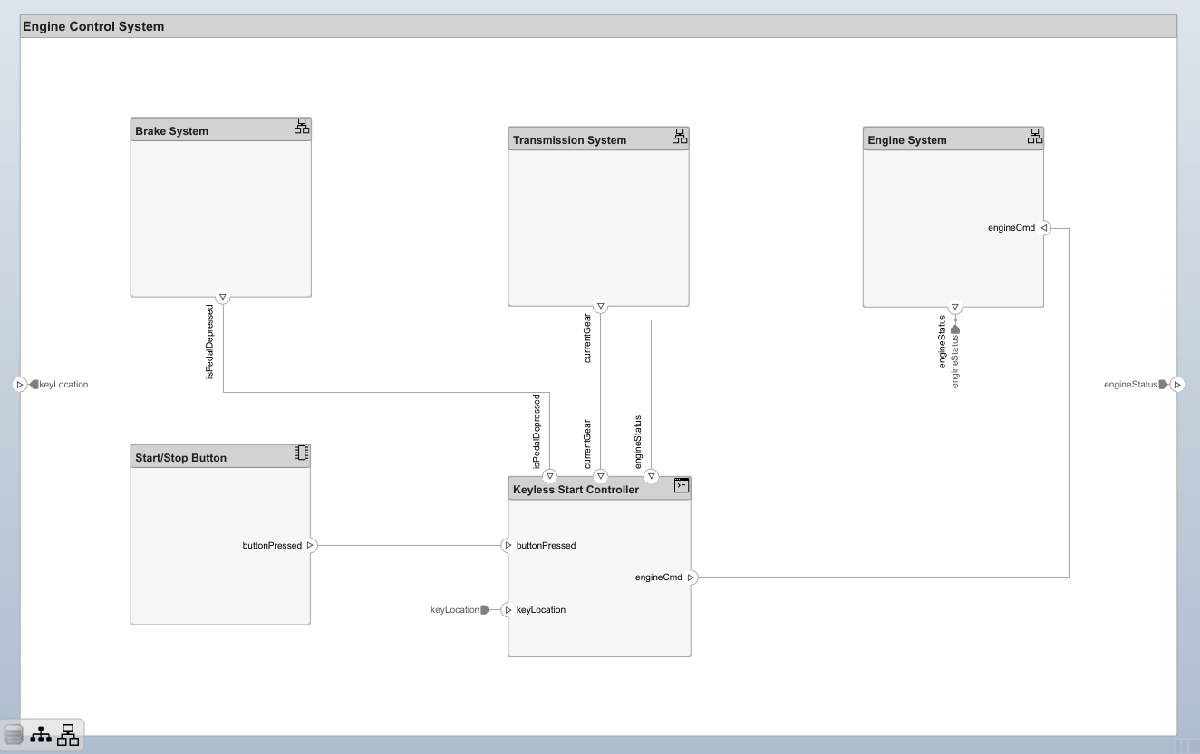
来自 keyLocation 的 FOB Locator System 信号进入 Keyless Start Controller 组件,该组件接收来自 Brake System、Transmission System 和 Engine System 组件的反馈。接下来,根据来自 Engine System 组件的 buttonPressed 信号,向 Start/Stop Button 发送信号以启动或停止车辆。
分解照明系统
无钥匙进入系统通过照明控制器向车辆发送指令,以激活前大灯和车内照明灯。
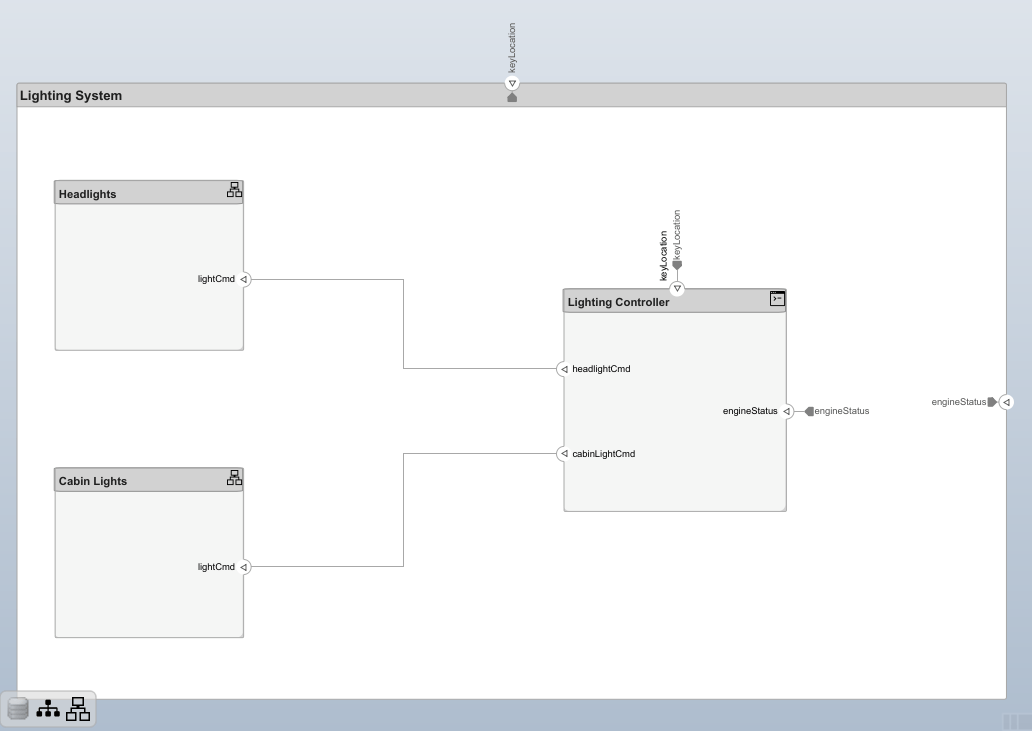
发送到 Lighting Controller 组件的发动机状态和键位置信息可能会激活由 Headlights 和 Cabin Lights 组件表示的不同指示灯。
定义构造型以对组件进行分类
架构中的所有组件都应用了适当的构造型。使用 配置文件编辑器 工具定义要应用于组件、端口、连接器和接口的配置文件、构造型和属性。每个组件构造型都从父构造型 BaseComponent 继承属性。对于每个构造型组件,您可以定义 Cost、ReviewStatus 或 Latency 属性值。
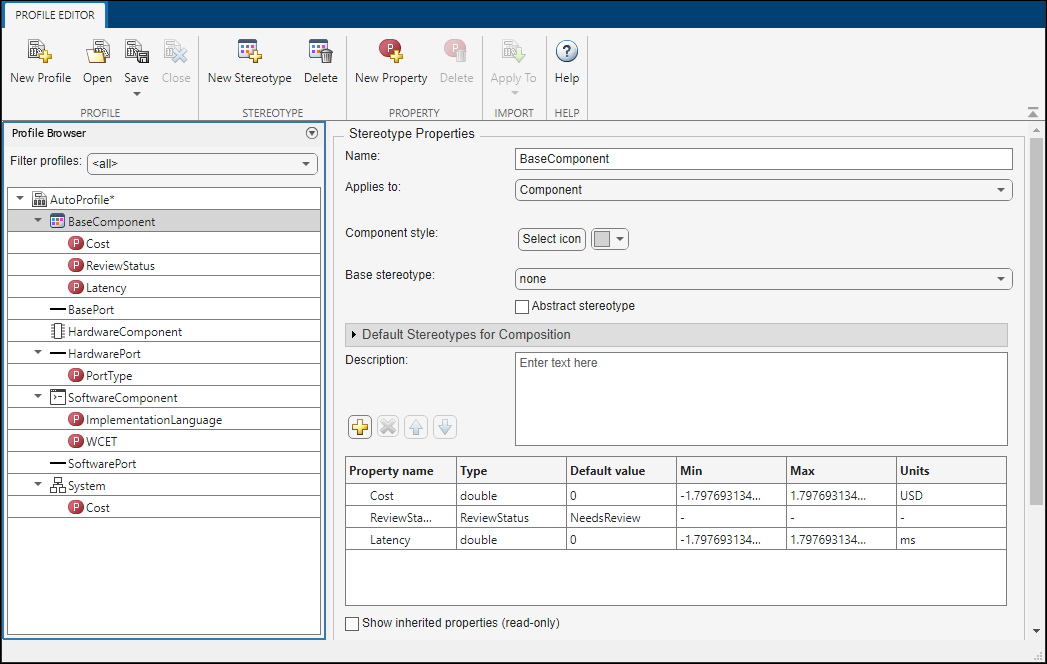
要对组件和端口进行构造型,首先将配置文件 AutoProfile 应用到顶层模型。每个组件构造型都包含一个图标,该图标代表构造型的用法并指示组件类型。要将构造型应用于批处理中的所有模型元素,请使用应用构造型工具。要启动该工具,请在工具条的建模选项卡中点击应用构造型。要逐一应用构造型,请使用“属性检查器”。有关详细信息,请参阅应用构造型来扩展模型元素。
定义端口接口以描述数据流
您可以使用分配给端口的数据接口和值类型来分解通过这些端口沿端口之间的连接传输的数据。例如,keyFOBPosition 接口描述了通过 keyLocation 端口传递到架构不同组件的信息元素。
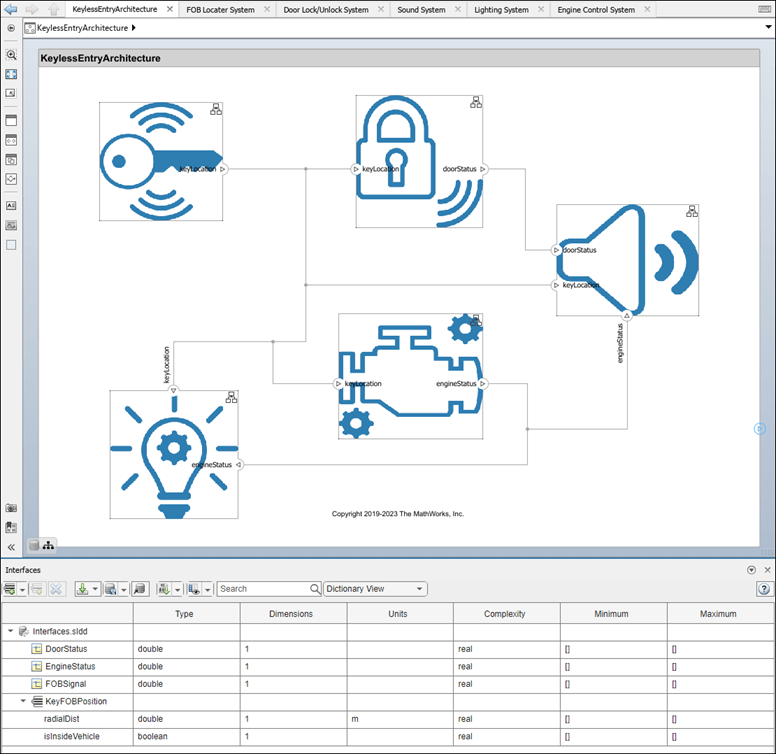
将复合数据接口(如 keyFOBPosition)分解为数据元素 radialDist 和 isInsideVehicle,就是 接口编辑器 设计的一个示例。您还可以通过添加其他数据接口或值类型(如 DoorStatus、EngineStatus 或 FOBSignal)的数据元素来分解数据接口。有关详细信息,请参阅将接口分配给端口。
创建供利益相关者查看的视图
您可以在 架构视图库 中创建、查看和编辑架构视图。要启动该工具,请在工具条的建模选项卡中点击架构视图。过滤后的视图会随着模型的变化而动态更新。或者,您可以使用聚焦视图,这是一种以特定组件为中心的临时视图。有关详细信息,请参阅创建聚焦视图。KeylessEntryArchitecture 模型具有以下视图:
键 FOB 位置数据流 - 显示模型中使用
KeyFOBPosition接口的组件的视图。
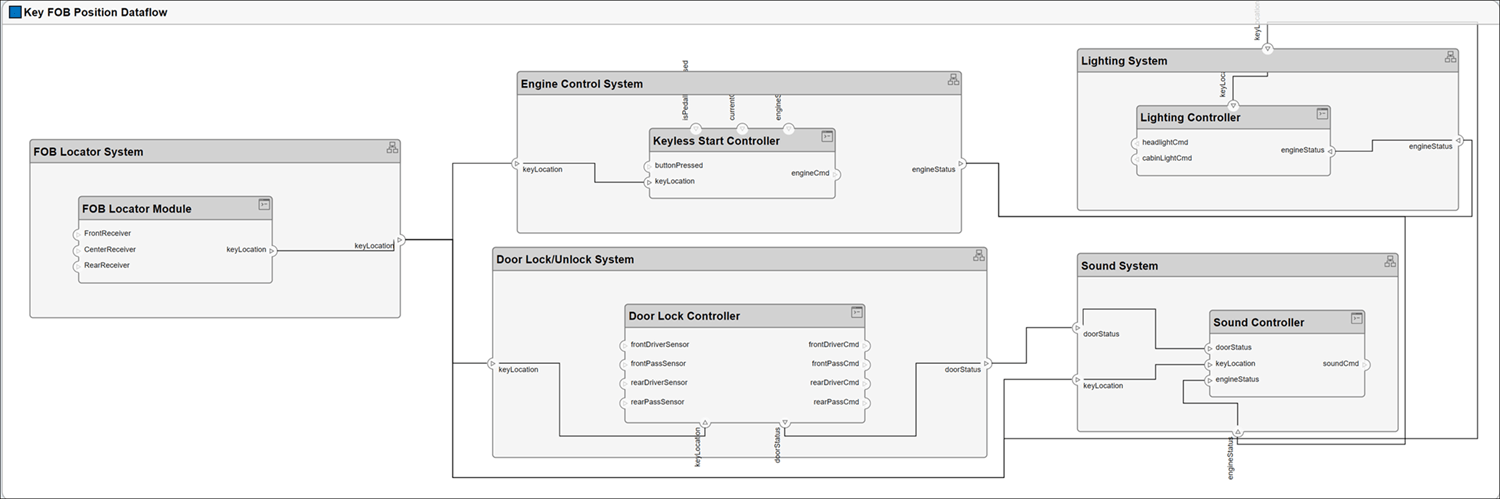
门锁系统供应商细分 - 按供应商提供的组件对门锁系统中的组件进行分类。

音响系统供应商细分 - 按供应商提供的组件对音响系统中的组件进行分类。

软件组件审查状态 - 显示应用了构造型
SoftwareComponent的模型中的组件,这些组件按属性ReviewStatus的值分组。

顶层组件 - 带封装图标的架构模型顶层组件视图。
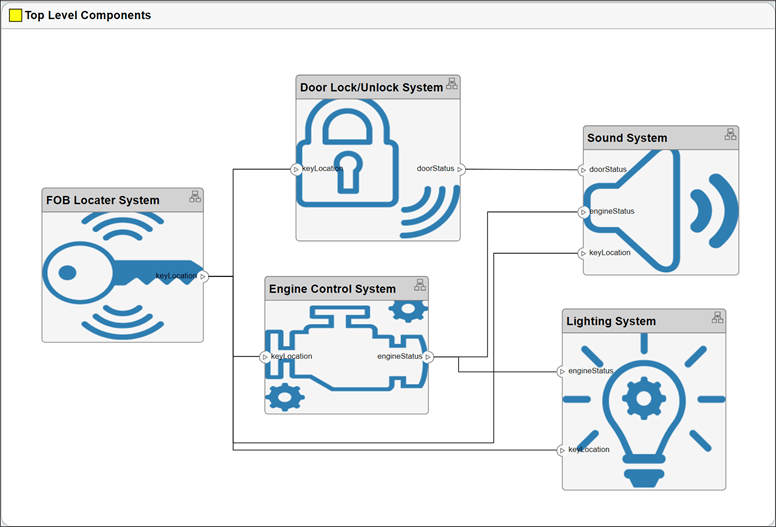
另请参阅
工具
函数
openViews|createView|getView|deleteView|modifyQuery|runQuery|removeQuery|addElement|removeElement|getQualifiedName|createSubGroup|getSubGroup|deleteSubGroup|getQualifiedName|lookup
对象
systemcomposer.view.View|systemcomposer.view.ElementGroup|systemcomposer.query.Constraint|systemcomposer.interface.DataInterface|systemcomposer.interface.DataElement